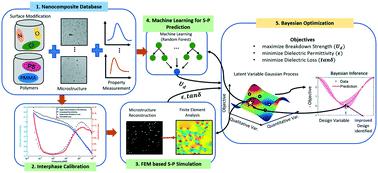当前位置:
X-MOL 学术
›
Mol. Syst. Des. Eng.
›
论文详情
Our official English website, www.x-mol.net, welcomes your feedback! (Note: you will need to create a separate account there.)
Data centric nanocomposites design via mixed-variable Bayesian optimization
Molecular Systems Design & Engineering ( IF 3.6 ) Pub Date : 2020-08-10 , DOI: 10.1039/d0me00079e Akshay Iyer 1, 2, 3 , Yichi Zhang 1, 2, 3 , Aditya Prasad 3, 4 , Praveen Gupta 3, 4 , Siyu Tao 1, 2, 3 , Yixing Wang 1, 2, 3 , Prajakta Prabhune 3, 5, 6 , Linda S. Schadler 1, 3, 7 , L. Catherine Brinson 3, 5, 6 , Wei Chen 1, 2, 3
Molecular Systems Design & Engineering ( IF 3.6 ) Pub Date : 2020-08-10 , DOI: 10.1039/d0me00079e Akshay Iyer 1, 2, 3 , Yichi Zhang 1, 2, 3 , Aditya Prasad 3, 4 , Praveen Gupta 3, 4 , Siyu Tao 1, 2, 3 , Yixing Wang 1, 2, 3 , Prajakta Prabhune 3, 5, 6 , Linda S. Schadler 1, 3, 7 , L. Catherine Brinson 3, 5, 6 , Wei Chen 1, 2, 3
Affiliation

|
With an unprecedented combination of mechanical and electrical properties, polymer nanocomposites have the potential to be widely used across multiple industries. Tailoring nanocomposites to meet application specific requirements remains a challenging task, owing to the vast, mixed-variable design space that includes composition (i.e. choice of polymer, nanoparticle, and surface modification) and microstructures (i.e. dispersion and geometric arrangement of particles) of the nanocomposite material. Modeling properties of the interphase, the region surrounding a nanoparticle, introduces additional complexity to the design process and requires computationally expensive simulations. As a result, previous attempts at designing polymer nanocomposites have focused on finding the optimal microstructure for only a fixed combination of constituents. In this article, we propose a data centric design framework to concurrently identify optimal composition and microstructure using mixed-variable Bayesian optimization. This framework integrates experimental data with state-of-the-art techniques in interphase modeling, microstructure characterization and reconstructions and machine learning. Latent variable Gaussian processes (LVGPs) quantifies the lack-of-data uncertainty over the mixed-variable design space that consists of qualitative and quantitative material design variables. The design of electrically insulating nanocomposites is cast as a multicriteria optimization problem with the goal of maximizing dielectric breakdown strength while minimizing dielectric permittivity and dielectric loss. Within tens of simulations, our method identifies a diverse set of designs on the Pareto frontier indicating the tradeoff between dielectric properties. These findings project data centric design, effectively integrating experimental data with simulations for Bayesian Optimization, as an effective approach for design of engineered material systems.
中文翻译:

通过混合变量贝叶斯优化设计以数据为中心的纳米复合材料
凭借机械和电气性能的空前组合,聚合物纳米复合材料具有在多个行业中广泛使用的潜力。定制纳米复合材料以满足特定的应用需求仍然是一项艰巨的任务,因为巨大的混合变量设计空间包括成分(即聚合物,纳米粒子和表面改性的选择)和微观结构(即纳米复合材料的颗粒的分散和几何排列)。相间的建模特性(围绕纳米粒子的区域)为设计过程带来了额外的复杂性,并且需要计算量大的仿真。结果,先前设计聚合物纳米复合材料的尝试集中于仅针对组分的固定组合找到最佳的微观结构。在本文中,我们提出了一个以数据为中心的设计框架,以使用混合变量贝叶斯优化同时确定最佳的成分和微观结构。该框架将实验数据与相间建模,微结构表征和重建以及机器学习中的最新技术集成在一起。潜在变量高斯过程(LVGP)量化了由定性和定量材料设计变量组成的混合变量设计空间中数据缺乏的不确定性。电绝缘纳米复合材料的设计被视为多准则优化问题,其目标是最大化介电击穿强度,同时最小化介电常数和介电损耗。在数十次仿真中,我们的方法在Pareto边界上确定了一组不同的设计,这些设计表明了介电性能之间的平衡。这些发现以数据为中心的设计,有效地将实验数据与贝叶斯优化模拟相结合,是设计工程材料系统的有效方法。
更新日期:2020-09-28
中文翻译:

通过混合变量贝叶斯优化设计以数据为中心的纳米复合材料
凭借机械和电气性能的空前组合,聚合物纳米复合材料具有在多个行业中广泛使用的潜力。定制纳米复合材料以满足特定的应用需求仍然是一项艰巨的任务,因为巨大的混合变量设计空间包括成分(即聚合物,纳米粒子和表面改性的选择)和微观结构(即纳米复合材料的颗粒的分散和几何排列)。相间的建模特性(围绕纳米粒子的区域)为设计过程带来了额外的复杂性,并且需要计算量大的仿真。结果,先前设计聚合物纳米复合材料的尝试集中于仅针对组分的固定组合找到最佳的微观结构。在本文中,我们提出了一个以数据为中心的设计框架,以使用混合变量贝叶斯优化同时确定最佳的成分和微观结构。该框架将实验数据与相间建模,微结构表征和重建以及机器学习中的最新技术集成在一起。潜在变量高斯过程(LVGP)量化了由定性和定量材料设计变量组成的混合变量设计空间中数据缺乏的不确定性。电绝缘纳米复合材料的设计被视为多准则优化问题,其目标是最大化介电击穿强度,同时最小化介电常数和介电损耗。在数十次仿真中,我们的方法在Pareto边界上确定了一组不同的设计,这些设计表明了介电性能之间的平衡。这些发现以数据为中心的设计,有效地将实验数据与贝叶斯优化模拟相结合,是设计工程材料系统的有效方法。


























 京公网安备 11010802027423号
京公网安备 11010802027423号